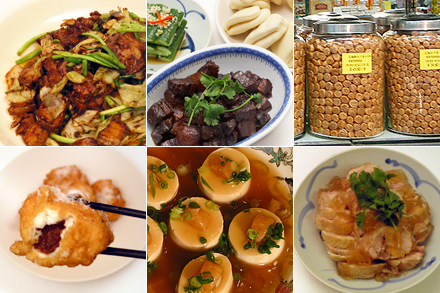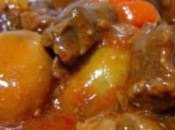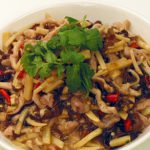Sunday, October 10, 2010
It was the Holy Week break and I’m back in San Fernando, La Union for a much needed
break. One of the things I looked forward to is savoring a freshly cooked Buridibud, a vegetable soup I so love that is just not available in Metro Manila. I enjoyed it so much that I volunteered this Philippine food piece to Tsibog so that visitors will be aware of Ilocano food and recipe as found and practiced in my hometown of San Fernando, La Union.
Posted in Filipino Food Recipes, Recipes 4 Comments »
google_protectAndRun("render_ads.js::google_render_ad", google_handleError, google_render_ad);
Crepes and Fillings Recipes Made Easy
July 5th, 2007 by Valerie Tort
By Valerie Tort
Crepe is a break in the routine of a fast food nation since it is easy to prepare and quick to cook. Crepe is also a versatile choice for diners who wanted to try something new most of the time.
Making crepes can utilize those leftovers in the refrigerator and transform them into another dish. Crepes vary according to their fillings. Fillings may be a dessert-like treat glazed with caramel, chocolate, or your choice of sauce or a sumptuous savory lunch/dinner packed with protein-rich meat and vegetables.
Get great Crepe Recipes for dessert
Posted in Filipino Food Recipes, Pinoy Desserts, Recipes 6 Comments »
Bibingka Royale All-Year Round
June 18th, 2007 by Valerie Tort
by Valerie Tort
Bibingka is one of the local terms used to describe Filipino rice cakes. The Filipino specialty can be eaten for breakfast or for merienda. Bibingka Royale is a soft, fluffy, and cake-like dessert with a slight sticky texture unlike the traditional bibingka made from glutinous rice topped with coco jam.
No need to wait for the Christmas songs to play and the well-lit lanterns to be displayed in front of the village houses to have a taste of Bibingka Royale. Even beginners can prepare and cook Bibingka Royale at the comfort of their homes without the hassle.
Get the Bibingka Royale recipe
Posted in Filipino Food Recipes, Recipes 8 Comments »
Miso: Asian Cuisine’s Secret Ingredient
June 4th, 2007 by Valerie Tort
By Valerie Tort
The Asian art of cooking introduced a hearty mix of dining pleasure, distinct satisfaction, and protection against diseases with miso.
Miso is the star of the homegrown dishes. Now, it makes me wonder what magic does miso have that it is treated in such a way that other spices and ingredients would be jealous of. What is miso?
More about Miso, favorite Asian cooking ingredient
Posted in Filipino Food Recipes, Special Features 1 Comment »
Simple Breaded Tofu Recipe
June 1st, 2007 by Gerry D
Tofu, or bean curd, tokwa to Pinoys, is a big part of Filipino and Asian cooking, particularly in Japanese and Chinese cuisine.
One particular and very simple way to cook tofu is to smother it with bread crumbs and deep fried. Breaded Tofu with accompanying sauce is great for appetizers, pulutan, and good enough to eat with rice for a full meal.
Get simple Breaded Tofu & Tofu Sauces recipes
Posted in Filipino Food Recipes, Recipes 5 Comments »
Sisig Sizzles the Pinoy Appetite
May 10th, 2007 by Gerry D
Sisig, the ultimate pulutan companion for beer. Around bars and restaurants, the many varieties of sisig dish is a best seller either to go along your favorite drink or to be chowed down with hot steamed rice.
Sisig is truly Filipino. From what I heard it was concocted by the food loving folks in Pampanga. In fact there’s a place in Angeles City, about 10 minutes drive from Clark, where you will find authentic sisig being served. Some even claim this was the place where this humble dish originated.
Get the original Pampanga Sisig recipe
Posted in Dining Guide, Filipino Food Recipes, Food Review 23 Comments »
Special Mother’s Day Recipe
April 26th, 2007 by Ugly_betty
On May 13 we will be celebrating Mother’s Day-one special occassion for one special person– our Mom. Every year I look forward to Mother’s day because on this day, my Nanay would always cook special menu for the family.
This year, my sister told me if we can cook for Nanay this time, instead of her cooking for us. I thought it’s a good idea and so i browse on recipe books and found this two simple recipe for Nanay that we’ll cook on Mother’s Day. Since mom, loves Pinoy food, we chose to cook for her Pinoy recipe with a twist.
beef
Estimated preparation & cooking time: 30 minutes
Beef Tapa Ingredients:
1/2 kilo lean beef, thinly sliced
1/2 cup fish sauce (patis)
1/4 cup refined sugar
3 teaspoons salt
1 head garlic, crushed and minced
1 teaspoon ground pepper
1/2 cup cooking oil
Beef Tapa Cooking Instructions:
Mix all ingredients in a mixing bowl
Marinate for at least an hour or keep in the refrigerator overnight.
In a large wok, heat cooking oil.
Fry the marinated beef for 15 minutes or until golden brown.
Serve hot with steamed rice or fried rice.
Serving Tip:
Beef tapa goes great with any of the following:
Atchara (pickled green papaya).
White vinegar with hot chili peppers
Sliced red tomatoes.
With fried egg.
Ingredients:
300g labahita fillet, cut into large chunks
1/2 tsp ginger juice
1/4 cup cornstarch
5 cloves garlic, crushed
1 pc medium onion, chopped
1 pc beef bouillon cube
4 strings sitaw, cut into 2” pieces
1 pc puso ng saging (banana heart), trimmed and sliced
1 pc large eggplant, sliced
1 tbsp atsuete juice
1 pouch (115 g) DEL MONTE Original Style Tomato Sauce
1 tbsp rice flour
3 tbsp toasted peanuts, pounded
2 heads native pechay
Procedures:
Sprinkle the ginger juice into fish , add 1/4 tsp iodized fine salt (or 1/4 tbsp iodized rock salt) and 1/8 tsp pepper. Coat each piece with cornstarch, then fry until golden brown. Set aside.
Sauté the garlic, onion and bouillon cube. Add 1-3/4 cups water, sitaw, puso ng saging, eggplant and atsuete juice. Season with salt and pepper to taste. Simmer for 20 minutes. Add DEL MONTE Tomato Sauce. Simmer for 5 minutes.
Add the remaining ingredients and fish. Simmer until pechay is cooked. Serve with sautéed bagoong alamang.
source: kitchenomics
Twisted Chicken Pandan Recipe
Ingredients:
chicken breast
soy sauce
tapioca flour
sesame oil
black pepper
roasted sesame seeds
oil (for frying)
pandan leaves
fresh buko
Procedures:
Mix the chicken with soy sauce, tapioca flour, sesame oil, black pepper and roasted sesame seeds.
Wrap the chicken breast fillets in pandan leaves.
Fry.
Top with fresh buko strips before serving for a twist.
google_protectAndRun("ads_core.google_render_ad", google_handleError, google_render_ad);
Saturday, October 9, 2010

Following in the footsteps of the Omnivore’s 100 quiz Diana Kuan, at Appetite for China, has created a “100 Chinese Foods to Try Before You Die” list. Diana listed 100 food items of Chinese or Asian origin to see if you’ve tried. It is probably not fair for me to take this quiz as I grew up with many of these items, and continue to explore them whenever I travel to Asia or China. But it is a fun list! So here it is… I scored 92 and there are two items that I wouldn’t be caught dead trying.
Using the same rules as the Omnivore’s 100 quiz, foods I’ve tried are in bold and the ones crossed out are what I wouldn’t try.
- Almond milk
- Ants Climbing a Tree (poetic, not literal, name)
- Asian pear
- Baby bok choy
- Baijiu
- Beef brisket
- Beggar’s Chicken
- Bingtang hulu
- Bitter melon
- Bubble tea
- Buddha’s Delight
- Cantonese roast duck
- Century egg, or thousand-year egg
- Cha siu (Cantonese roast pork)
- Char kway teow
- Chicken feet
- Chinese sausage
- Chow mein
- Chrysanthemum tea
- Claypot rice
- Congee
- Conpoy (dried scallops)
- Crab rangoon
- Dan Dan noodles
- Dragonfruit
- Dragon’s Beard candy
- Dried cuttlefish
- Drunken chicken
- Dry-fried green beans
- Egg drop soup
- Egg rolls
- Egg tart, Cantonese or Macanese
- Fresh bamboo shoots
- Fortune cookies
- Fried milk
- Fried rice
- Gai lan (Chinese broccoli)
- General Tso’s Chicken
- Gobi Manchurian
- Goji berries (Chinese wolfberries)
- Grass jelly
- Hainan chicken rice
- Hand-pulled noodles
- Har gau (steamed shrimp dumplings in translucent wrappers)
- Haw flakes
- Hibiscus tea
- Hong Kong-style Milk Tea
- Hot and sour soup
- Hot Coca-Cola with Ginger
- Hot Pot
- Iron Goddess tea (Tieguanyin)
- Jellyfish
- Kosher Chinese food
- Kung Pao Chicken
- Lamb skewers (yangrou chua’r)
- Lion’s Head meatballs
- Lomo Saltado
- Longan fruit
- Lychee
- Macaroni in soup with Spam
- Malatang
- Mantou, especially if fried and dipped in sweetened condensed milk
- Mapo Tofu
- Mock meat
- Mooncake (bonus points for the snow-skin variety)
- Nor mai gai (chicken and sticky rice in lotus leaf)
- Pan-fried jiaozi
- Peking duck
- Pineapple bun
- Prawn crackers
- Pu’er tea
- Rambutan
- Red bean in dessert form
- Red bayberry
- Red cooked pork
- Roast pigeon
- Rose tea
- Roujiamo
- Scallion pancake
- Shaved ice dessert
- Sesame chicken
- Sichuan pepper in any dish
- Sichuan preserved vegetable (zhacai)
- Silken tofu
- Soy milk, freshly made
- Steamed egg custard
- Stinky tofu
- Sugar cane juice
- Sweet and sour pork, chicken, or shrimp
- Taro
- Tea eggs
- Tea-smoked duck
- Turnip cake (law bok gau)
- Twice-cooked pork
- Water chestnut cake (mati gau)
- Wonton noodle soup
- Wood ear
- Xiaolongbao (soup dumplings)
- Yuanyang (half coffee, half tea, Hong Kong style)
- Yunnan goat cheese
Similar Posts:
Filipino Recipes
Welcome to the Filipino recipes site. Featured on this site are free Filipino recipes that have become all time Philippine favorites. Traditional Filipino food recipes that are simple to cook and always a pleasure to serve and eat... dishes that are always welcome on the dining table. Filipino food consist mostly of vegetables, seafood, dairy, meat and rice. Like Philippine fiestas, Filipino recipes are rich in flavour & color.
 |
Filipino culinary arts is greatly influenced by Chinese, European, American, Arab and Asian cuisines. A fusion of various recipes adopted from earlier traders, Asian immigrants and former colonizers.
Before the Spaniards colonized the Philippines, the country's cuisine consisted of root crops, game, vegetables and seafood. Filipino food recipes then was almost always either boiled, roasted or broiled. Foreign trade brought in all kinds of spices and plants to the Philippines. And like the Filipino today, its cuisine is a gastronomic feast from different countries and cultures - from east to west.
Filipinos have embraced as their own cuisines form other countries like the noodles from the Chinese, rice and meat dishes from the Spaniards, fast-food from the Americans and even spaghetti from the Italians. All these now form part of the Philippine cuisine - with the Filipino touch, of course.
There are however many Filipino recipes from each region of the Philippines with each region having its own unique specialty. The Ilocanos from the north are known for their Pakbet - a simple but nutritious vegetable dish. While the Bicolanos are famous for their Bicol Express a hot and spicy dish simmered in coconut milk. Overall, nothing beats the fame of the tasty pork and chicken Adobo, a dish the Philippines is known for throughout the world.
Experience the tastes and colors of Philippine food. A gastronomic delight that has been savored through many generations. Enjoy the free Filipino food recipes on this site and happy cooking!
Halayang Ube (Purple Yam Jam) Recipe
Estimated preparation and cooking time: 2 hours
Halayang Ube Ingredients: |
-
1 kilo ube yam root
-
1 can (14 ounces) evaporated milk
-
2 cans (12 ounces) condensed milk
-
1/2 cup butter or margarine
-
1/2 teaspoon of vanilla (optional)
Halayang Ube Cooking Instructions: |
-
On a pot, boil the unpeeled ube yam in water and simmer for 30 minutes. Drain and let cool.
-
Peel and finely grate the ube yam.
-
Heat a big wok in medium heat.
-
Melt butter or margarine, add the condensed milk and vanilla flavoring. Mix well.
-
Add the 1 kilo grated ube yam,
-
Adjust the heat to low
-
Keep on mixing the ingredients for about 30 minutes or until sticky and a bit dry (but still moist).
-
Add the evaporated milk and continue to mix for another 15 minutes.
-
Let cool and place on a large platter.
-
Refrigerate before serving the halayang ube.
Cooking Tips: |
-
You may spread additional butter or margarine on top of the jam before serving.
-
For the sweet toothed, sprinkle a little sugar on top of the jam after placing on the large platter.
-
Instead of manually grating the ube, you may cut it in cubes and use a blender to powderize the ube.
marca
Baked Macaroni And Cheese
Here is a good baked mac and cheese recipe for you. I know, this is not a Filipino (originated) recipe but more and more Filipinos are starting to like and love this dish. One evidence is the instant bake mac and cheese being offered in some Philippine stores and supermarkets.
You may use nearly any pasta-tube, corkscrew, or cupshaped ones work best because they grab the sauce-just be sure to slightly undercook whatever pasta you use since it will continue to cook in the oven.
Vary the type of cheese you use too: try blue cheese, goat cheese, smoked Gouda, or even mascarpone for a decadent version.
This recipe makes 4 to 6 servings. The time consumed in making and baking this dish is about 45 minutes.

Baked Macaroni And Cheese Recipe Ingredients:
* Salt
* 2 1/2 cups milk (low-fat is fine)
* 2 bay leaves
* 1 pound elbow, shell, ziti, or other cut pasta
* 4 tablespoons (1/2 stick) butter
* 3 tablespoons all-purpose flour
* 1 1/2 cups grated cheese, like sharp cheddar or Emmental
* 1/2 cup freshly grated Parmesan cheese
* Freshly ground black pepper
* 1/2 cup or more bread crumbs, preferably fresh
Baked Macaroni And Cheese Recipe Baking/Cooking Procedure:
1). Preheat the oven to 400°F. Bring a large pot of water to a boil and salt it.
2). Cook the milk with the bay leaves in a small saucepan over medium-low heat. When small bubbles appear along the sides, about 5 minutes later, turn off the heat and let stand.
3). Cook the pasta to the point where it is almost done but you would still think it needed another minute or two to become tender. Drain it, rinse it quickly to stop the cooking, and put it in a large bowl.
4). In a small saucepan over medium-low heat, melt 3 tablespoons of the butter; when it is foamy, add the flour and cook, stirring, until the mixture browns, about 5 minutes. Remove the bay leaves from the milk and add about 1/4 cup of the milk to the hot flour mixture, stirring with a wire whisk all the while. As soon as the mixture becomes smooth, add a little more milk and continue to do so until all the milk is used up and the mixture is thick and smooth. Add the cheddar and stir.
5). Pour the sauce over the noodles, toss in the Parmesan, and sprinkle with salt and pepper. Use the remaining 1 tablespoon butter to grease a 9 x 13-inch or similar-size baking pan and turn the pasta mixture into it. Top liberally with bread crumbs and bake until bubbling and the crumbs turn brown, about 15 minutes. Serve piping hot.


